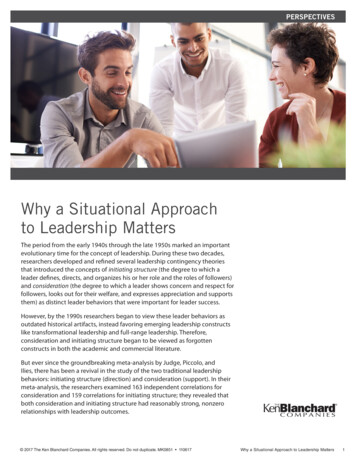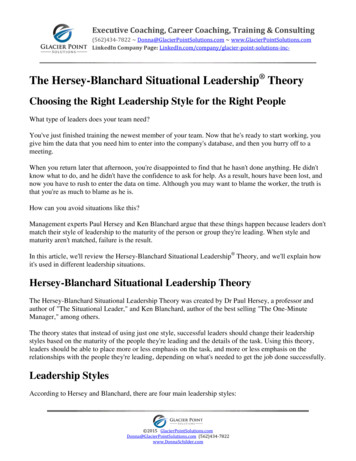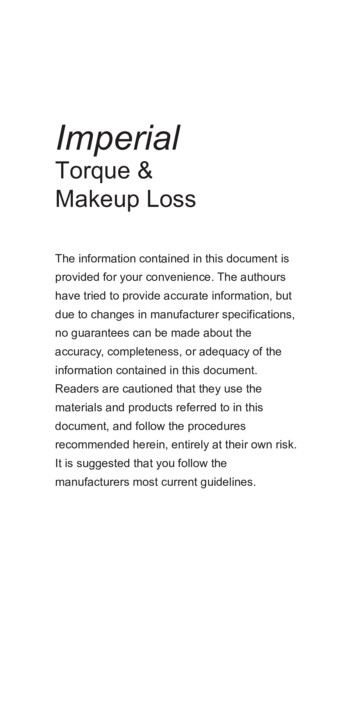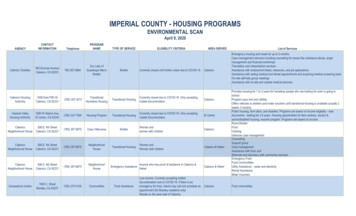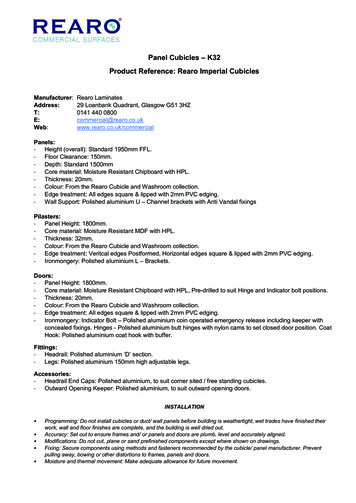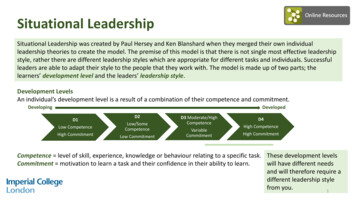
Transcription
Situational LeadershipSituational Leadership was created by Paul Hersey and Ken Blanshard when they merged their own individualleadership theories to create the model. The premise of this model is that there is not single most effective leadershipstyle, rather there are different leadership styles which are appropriate for different tasks and individuals. Successfulleaders are able to adapt their style to the people that they work with. The model is made up of two parts; thelearners’ development level and the leaders’ leadership style.Development LevelsAn individual’s development level is a result of a combination of their competence and commitment.DevelopingDevelopedD1D2Low CompetenceLow/SomeCompetenceHigh CommitmentLow CommitmentD3 Moderate/HighCompetenceVariableCommitmentD4High CompetenceHigh CommitmentCompetence level of skill, experience, knowledge or behaviour relating to a specific task. These development levelsCommitment motivation to learn a task and their confidence in their ability to learn.will have different needsand will therefore require adifferent leadership stylefrom you.1
Leadership StylesThe four leadership styles of Situational Leadership offervarying degrees of support and direction. The leadership stylescan be mapped across the development levels as below.Three key considerations to remember are:1) The importance of matching the development level to thecorrect leadership style. The consequences of“mismatching” can be detrimental to the learner. Forexample, being highly directive of someone andmicromanaging their workload when in reality they requirea more hands off delegating style.2) An individual may need a different leadership style indifferent tasks – just because someone is D4 (highlycompetent and highly committed) on part of their role,doesn’t mean they are D4 in all of them.3) An individual can move back and forward through theDevelopment Levels over time, so don’t assume justbecause someone was D4, they will remain so –commitment or competency can drop too!When establishing a learner’s development level askyourself:1) What is the specific task?2) How good is the individual’s demonstratedknowledge and skills?3) How good are their transferable skills?4) How motivated, interested or enthusiastic arethey?5) How confident / self-assured are they?Every leader will have a natural preference that they will usepredominately.What do you think is your natural preference?Having an awareness of this is important so you are able to flex yourstyle when needed.2
Let’s Talk – Team MemberDecidesLow DirectiveHigh SupportiveTeam Member DecidesLow DirectiveLow ctingLet’s Talk – Leader DecidesHigh DirectiveHigh SupportiveLeader DecidesHigh DirectiveLow Supportive3
Matching development level toleadership styleDevelopment Level 1 – Enthusiastic BeginnerFeels: Inexperienced Curious Optimistic Excited Eager Enthusiastic HopefulNeeds Leadership Style 1 – Directive Clear goals and rolesRecognition of enthusiasm and transferable skillsTimelines and prioritiesWhat good looks likeAction plans – specific direction, how, when etcBoundaries and limits4
Matching development level toleadership styleDevelopment Level 2 – Disillusioned LearnerFeels: Overwhelmed Confused Demoralised Frustrated Discouraged Disillusioned Flashes of confidenceNeeds Leadership Style 2 – Coaching Clear goalsPerspectiveFrequent feedbackPraise for making progressHelp in analysing successes and failures Explanations of why the task is important5
Matching development level toleadership styleDevelopment Level 3 – Capable but Cautious PerformerFeels: Self critical Cautious Doubtful Capable Contributing Insecure Tentative / unsureNeeds Leadership Style 3 – Supporting An approachable mentor or coach Opportunities to test ideas Opportunities to express concerns and sharefeelings Support and encouragement to develop self-reliantproblem solving skills6
Matching development level toleadership styleDevelopment Level 4 – Self Reliant AcheiverFeels: Justifiably confident Consistently competent Inspired / Inspires others Expert Autonomous Self-assured Self-reliant Self-directedNeeds Leadership Style 4 – Delegating Variety and challengeA leader who is more of a mentor and colleagueAcknowledgement of contributionsAutonomy and authorityTrustOpportunity to share knowledge and skills7
Situational Leadership was created by Paul Hersey and Ken Blanshard when they merged their own individual leadership theories to create the model. The premise of this model is that there is not single most effective leadership style, rather there are different leadership styles which are appropriate for different tasks and individuals. Successful


